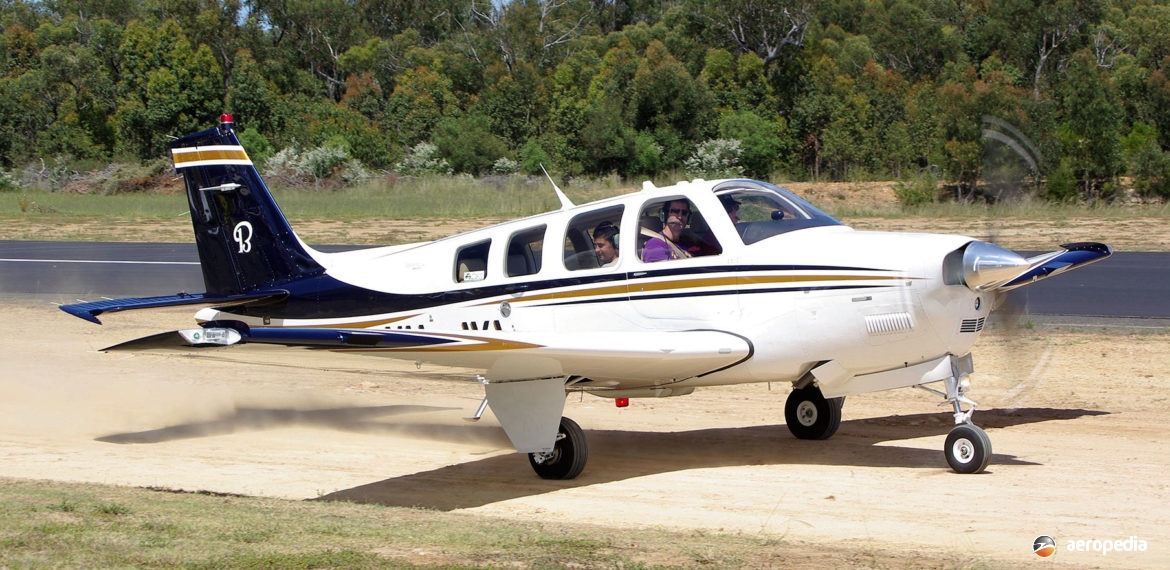Photograph:
Beech G36 Bonanza VH-JKL (c/n E-3974) at Wedderburn, NSW in 2008 (David C Eyre)
Country of origin:
United States of America
Description:
Four/six-seat cabin monoplane
Power Plant:
(A36)
One 224 kw (300 hp) Continental IO-550-B six-cylinder horizontally-opposed air-cooled engine
Specifications:
- Wingspan: 10.21 m (33 ft 6 in)
- Length: 8.38 m (27 ft 6 in)
- Height: 2.57 m (8 ft 5 in)
- Wing area: 16.8 m² (181 sq ft)
- Max speed at sea level: 340 km/h (212 mph)
- Max cruising speed at 1,830 m (6,000 ft): 326 km/h (202 mph)
- Stalling speed flaps down: 109 km/h (68 mph)
- Max rate of climb at sea level: 368 m/min (1,210 ft/min)
- Service ceiling: 3,638 m (18,500 ft)
- Range at max cruise at 3,600 m (12,000 ft) with 45 mins reserve: 1,622 km (1,009 miles)
- Empty weight: 1,019 kg (2,247 lb)
- Loaded weight: 1,655 kg (3,650 lb)
History:
The Beech 36 series was a development of the V35 ‘V’-tail series built with a conventional tail unit, with swept-back vertical tail surfaces, and an extended cabin. It was first conceived in 1968. In addition, the A36 had larger double doors on the starboard side aft of the wing-root to facilitate loading and unloading of bulky cargo when the aircraft was used in the utility role. When released it received the award of Plane of the Year. At that time, in 1980, it was claimed to be the market leader in general aviation’s advanced single-engine category, being described in the A36 model as having ‘true six-place seating, an enlarged baggage hold and the capability to whisper along at nearly 306 km/h (190 mph) with a measly 65% power setting applied – drinking less than 41.6 litres (11 US gals – 9.15 Imp gals) for each 60 minute flight’.
The Beech 33 Debonair series was conceived in the late 1950s as a low-cost derivative of the Model 35 Bonanza series and some 3,352 had been completed when the Beech Company decided to stop production of the Models 33 and 35 at Wichita in Kansas, USA and just produce a new model known as the 36. Over 3,800 of the latter have been produced and production continued with 71 delivered during 2005.
Compared with the Model 35, the Model 33, and later the Model 36, had a conventional three-surface tail unit. When released in 1968 the Model 36 had a longer cabin, a 213 kw (285 hp) engine, and increased weights. Subsequently turbocharged variants appeared, the first in 1978, this being known as the A36TC, of which 271 were built. This gave way to the revised B36TC in 1982 with a greater wingspan and increased fuel capacity. Later the B36C and B36TC models appeared, the latter fitted with a 224 kw (300 hp) Continental TSIO-520-UP engine, this having the wingspan increased to 11.53 m (37 ft 10 in), a wing area of 17.47 m² (188.1 sq ft), and a maximum take-off weight of 1,746 kg (3,850 lb).
One example of the Model 36 was modified as the T36TC. This aircraft was fitted with a 242 kw (325 hp) Continental TSIO-520 six-cylinder turbocharged engine in an extended cowling and with a T-tail, the aircraft being registered N2065T and being flown for the first time in 1979. This model did not go into production and the sole prototype ended up in the Beech scrapyard at Wichita in August 1984.
In 1997 a Bonanza, the 17,375th built, was painted in a special colour scheme to mark the 50th Anniversary of production of the Bonanza series. In more recent times examples have had turbine engines, including the Pratt & Whitney PT-6 and the Allison 250-B17C, installed to increase performance, and an example of this model was imported to Australia in early 2004, becoming VH-XSG (c/n E2672).
The Beech 36 series, more recently marketed as the Raytheon Beechcraft Bonanza, has been very successful in this region with 113 examples registered in Australia and two in New Zealand.

